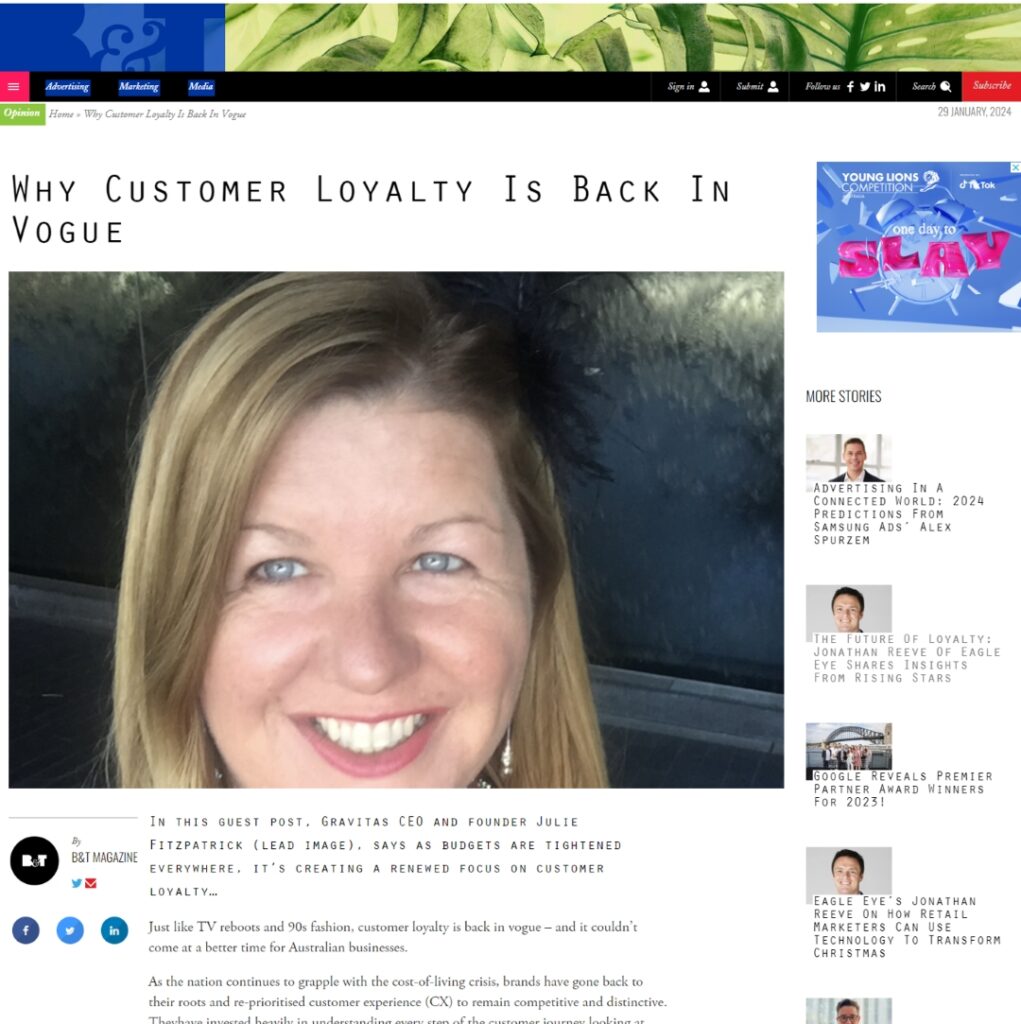In this B&T guest post, Gravitas CEO and founder Julie Fitzpatrick, says as budgets are tightened everywhere, it’s creating a renewed focus on customer loyalty…
Just like TV reboots and 90s fashion, customer loyalty is back in vogue – and it couldn’t come at a better time for Australian businesses.
As the nation continues to grapple with the cost-of-living crisis, brands have gone back to their roots and re-prioritised customer experience (CX) to remain competitive and distinctive. They have invested heavily in understanding every step of the customer journey looking at how buyers interact and engage with their store, in an effort to convert one-off customers to brand advocates and loyal shoppers for life.
The strategy is solid, particularly as consumer spend continues to decline. Instead of focusing on bringing in thousands of new buyers, businesses should now look to their existing customers, and their brand loyalty, to unlock incremental value.
Customer retention has always been a core part of marketing strategy, particularly across the retail sector, but it’s given way in recent years to the explosion of ecommerce and the desire to create a seamless omnichannel experience. In the haste to grow and service online customers, particularly during the pandemic, many retailers have forgotten the importance of their loyal customer base and the need to leverage them in challenging economic times.
And challenging they are. With rising grocery prices, mortgage repayments, and fuel prices, Australian consumers are well and truly feeling the pinch and curbing their spending habits accordingly – many are making clear choices about when, how and what they spend, forcing businesses to vie for every customer dollar.
In a tight economy, consumers are more likely to trade brand preference for a cheaper price, particularly if they believe there’s minimal reward for their loyalty. That’s why brand incentivisation is essential. Businesses need to look at ways to maximise loyalty rewards and benefits to spike consumer interest – and keep them coming back. And it’s this loyalty that is liquid gold, particularly in a declining economy. Data shows keeping a customer is at least four times more cost-effective than gaining a new customer. Now is the time for brands to go back to CX basics (and their long-time customer bases) to unlock incremental value.
In good news, it’s easier than ever for businesses to leverage their customer bank – and target them accordingly. Gone are the days of tracking customer preferences on spreadsheets; advances in AI are now helping to predict customer behaviour like never before. For example, mobile apps and payments, originally driven by millennials and the pandemic’s need for contactless trade, have become almost embedded in BAU. Yes, these programs make it easy for brands to retain customer information – but there’s a value exchange involved. Today’s consumer wants a little something in exchange for their data. Whether it’s a discount on their next purchase, free shipping or loyalty points, value-adds are essential to ensuring customer retention.
Brands should see the market conditions as a good time to overhaul their loyalty program. The future of loyalty programs is set to become customer value management, where businesses unlock customer insights (‘big data’) to determine differentiated sales, service and loyalty treatment strategies, aligned to value and potential. It’s about leveraging machine-learning and AI to serve the right offer, to the right customer, in the right channel, at the right time. Basically, let the technology do the legwork, so marketers can spend more time on their business and on strategies to remain competitive and engaging.
So, what does this mean for marketers?
In the coming months, the priority for brands will be holding market share. Marketers will need strategies that keep customers close and maintain the lion’s share of their wallet, particularly as economic conditions continue to fluctuate.
With marketing budgets in the spotlight, brand loyalty will be critical. Marketers will need to return to basics and look to their existing customers for spend. Engagement will become key, with a focus on creativity, personalisation and simplicity. CX should ensure shoppers can easily understand, gain benefits and rewards, and join loyalty programs, while offering an experience that meets customers where they are. Expect to see brands tapping into psychological drivers and gamification techniques as they compete for attention.
Brands should also be leaning heavily on technology to improve CX. Investments in AI and predictive machine learning models are key to driving personalisation at scale. Differentiating offers, aligned to the values of each customer, will be crucial to cost-effectively extracting incremental revenue and maximising customer lifetime value.
Finally, marketers should make customer insights and trends available to all staff, including those on the frontline. Having access to data allows CX teams to make informed, real-time decisions to maximise the customer experience and value exchange. The importance of effective dispute resolution and problem-solving shouldn’t be underestimated – fixing issues quickly and without fuss can actually embed loyalty and brand stickiness.
As we head into the new year, marketers will need to overlay a value lens to everything they do to opitmise their budget and ROI effectiveness. The same approach should be taken by brands to CX and ask: “Are we doing everything possible to create a seamless customer journey that will see shoppers coming back time and time again?” Because when the chips are down, it’s customer loyalty that will buoy your business – and help take it to the next level.
Julie Fitzpatrick, CEO & Founder of Gravitas



